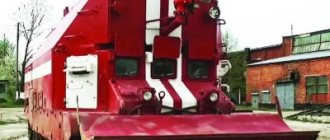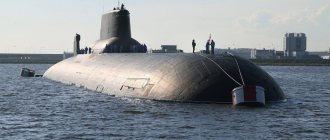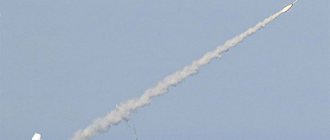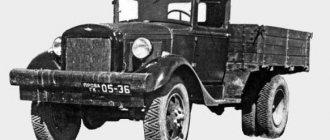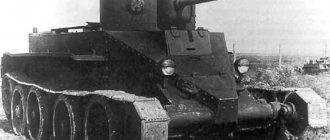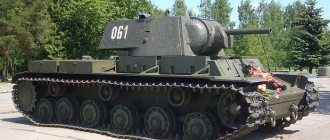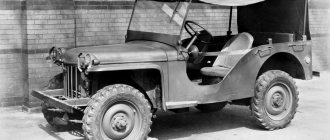A tracked fire engine is a tracked vehicle designed to extinguish fires and support the activities of the fire department.
A caterpillar track is a propulsion device for self-propelled vehicles, providing movement due to the interaction of the tracks with the ground.
Czech SPOT-55, created on the basis of the Soviet T-55 tank
Purpose
To extinguish the most complex and dangerous fires in hard-to-reach areas, for example: forest fires, fires in oil production or ammunition storage areas, tracked fire engines based on battle tanks are used. Such machines are equipped with a water or powder cannon that fires at a distance of up to 100 meters, and a large reservoir for water or foam concentrate. And thanks to the armored hull, the fire tank is not afraid of explosions and can get closer to the very source of the fire. Some of these tanks, such as the Russian SPM (special fire engine), can even be controlled remotely like robots!
Fire truck SPM - video
The fire truck was assembled at the Omsk Transport Engineering Plant by order of the Ministry of Defense. This “fire tank” is capable of firing a jet at a distance of 100 meters. A special feature of the SPM is the possibility of remote control, which ensures maximum safety of people involved in fire fighting in particularly difficult and dangerous conditions. If there is a threat to the life of the crew, people leave the vehicle, and it carries out the assigned task using a remote control system.
The ballistic protection of the SPM consists of removable armored anti-fragmentation screens, which, together with the armored cabin, provide protection for the crew and equipment in the cabin from flying fragments during a ground detonation of a high-explosive fragmentation projectile of 152 mm caliber.
The mass of the SPM is about 60 tons. The crew consists of three people. It is reliably protected by a sealed and thermally insulated cabin. The supply of water and fire extinguishing agents is 25 cubic meters, the fire extinguishing agent supply range reaches 100 meters. To clear approaches to fires and create mineralized strips, the machine is equipped with bulldozer equipment in the form of a wedge-shaped blade.
It is reported that the SPM crew is dressed in special heat-insulating, heat-resistant suits that can protect people from exposure to high temperatures. In addition, the crew is provided with the use of individual means of filtration and air purification.
History of creation
Since the late 40s of the 20th century, a fire engine on the T-34 chassis has been known, on the landing turret of which a standard hydraulic monitor with a flow rate of 30 l/s and a tank for 3-5 tons of water were mounted. This project was implemented in Siberia, where arsenals and ammunition depots are prone to frequent fires from forest fires. This fire truck was successfully used to extinguish fires in ammunition depots and burning forests around these depots. The crew of the vehicle consisted of 2 people - the driver and the operator who controlled the monitor, and was protected by projectile armor.
On this topic ▼
Methods and methods of extinguishing forest fires
In the early 70s, on the instructions of the Main Rocket and Artillery Directorate (GRAU) of the USSR Ministry of Defense, the GPM-54 tracked fire engine was developed, carrying 10 tons of water and up to 2 tons of foaming agent, with a fire monitor with a water supply intensity of up to 40 l/s. However, as practice has shown, this vehicle, although significantly superior in its fire-extinguishing capabilities to fire-fighting wheeled standard vehicles, for example AC-40, AA-40 (corresponding to 2-3 AC-40, 4-5 AA-40), and corresponded to airfield heavy fire engines AA-60 and AA-70, but without refueling or support from other fire engines, it was not independently capable of extinguishing a local fire in an ammunition stack after 6-8 minutes of free fire development. The chassis was unarmored, and the anti-missile armor was replaced by 20-mm sheets, capable of successfully protecting only from small arms or machine guns, but not capable of withstanding a direct hit from rockets or shells, which, as a rule, often scatter chaotically along various trajectories from burning stacks. The biggest drawback of the machine was that it was impossible to maneuver when supplying water, in particular, to quickly leave an area dangerous due to the thermal effects of a fire flame. Therefore, GPM-54 vehicles caught fire when extinguishing a stack from a distance of 10-20 m, but more often they simply could not approach the burning stack within effective extinguishing distance.
Tracked fire truck GPM-54 on an unarmored chassis of the T-54 tank
For example, to extinguish the fire of ammunition stacks at the 61st arsenal near Lozovaya, five GPM-54 “fire tanks” were brought. The first “tank” quickly failed due to engine overheating under the influence of thermal radiation and operation in an atmosphere depleted of oxygen and heavily polluted, which is typical for the GPM-54. The next day, four GPM-54s could not work because the temperature in the fire area was too high for them. Such cases have happened before. Thus, in 1982, at the largest arsenal of the Main Rocket and Artillery Directorate (GRAU) in Yoshkar-Ola, two GPM-54s with their crews burned down. The first vehicle, with an experienced driver, a warrant officer, and a fire monitor operator - the head of the on-site fire department, extinguished the burning stack from the most effective distance - 10 m. When the water supply ran out, the engine of the vehicle stalled due to heavy smoke, and they could not start it. The fire from the stack engulfed the car. The second car, led by the deputy chief of the unit, went to rescue the first, knocked out the flames from it, but its engine also stalled. As a result, both cars burned down along with their crews.
These shortcomings of the GPM-54 were noted in a number of orders for the GRAU of the USSR Ministry of Defense in 1983, and on their basis resolutions were adopted on the need to create new, armored GPMs. A new development was a pulsed multi-barrel installation on the chassis of the T-62 "Impulse-2M" tank with a turret 50-barrel installation, each barrel of which contains spray charges with electric igniters, 20-30 kg of sprayed OS or PM, depending on their density and humidity (in containers - liquid, viscous or powder; in the bore - loose, fixed on both sides with wads). The tracked armored fire engine (GBFM) "Impulse-2M" was created on the instructions of the GRAU of the USSR Ministry of Defense for remote extinguishing (from relatively safe distances - up to 100 m) of burning ammunition stacks. The chassis has been little changed:
- Ammunition racks have been removed, thereby increasing the free volume of the habitable compartment;
- crew evacuation was accelerated;
- filters for purifying air from toxic and radioactive dust, aerosols and armor protecting against shells, collapses and large fragments have been preserved.
Tracked armored fire fighting vehicle "Impulse-2M"
Replacing the turret with a gun with a multi-barrel module (MM) made it possible to lighten the chassis by 3-5 tons, increase the speed and maneuverability of the Impulse-2M, and install heat-reflective screens and pulse sprayers for external cooling and internal protection of the habitable and engine compartments. The barrels of a multi-barrel installation can be charged with various fire extinguishing agents: liquids, solutions, gels, powders and bulk materials, which for the first time will allow for simultaneous effective extinguishing and liquidation of the consequences of accidents. If the supply of containers with fire extinguishing agent runs out, then there are compact spray cartridges - up to 500 pcs. in ammunition racks for 10 barrel reloads.
For the first time, a fire engine has been created that can provide flexible extinguishing (in scale, range and type) by sequential spraying of various fire extinguishing and protective compositions (liquid, viscous, adhesive, gels, powders) and environmentally friendly natural materials (soil, dirt, dust, sand , snow, etc.). Additionally, at the request of the customer, the chassis and installation were equipped with light-heat-protective screens and had a heat-reflecting light color. Taking into account the experience of the death of GPM-54 vehicles with their crews when extinguishing burning stacks of ammunition, the developers provided on the new GBPM “Impulse-2M” pulse sprayers of water and gels fixed on the external armor, which, when sprayed, create a foam-like heat-absorbing layer on the body (armor) of the vehicle.
GBPM "Impulse-2M" has been in operation since the early 90s: 7 vehicles - in the site militarized fire departments (VPF) of Ukraine (Chernobyl, Poltava, Cherkassy, Chernigov region, Gnedintsy, Simferopol); 15 cars are in Russia (of which 4 are in Bashkortostan), 5 cars are in Yemen. However, as practice has shown, when operating the Impulse-2M GBPM, projectile-proof armor is necessary only in the event of direct hits from shells and missiles flying from burning stacks of ammunition boxes, and a tracked tank chassis creates considerable difficulties when operating in fire departments and is of little use for long marches and requires frequent regular repairs. The market for the Impulse-2M GBPM is limited, so it is advisable to design the MM on a vehicle chassis with a wide market, an established repair system and the supply of necessary spare parts.
The work of the Impulse-2M GBPM in Russia and Ukraine has provided rich material in terms of identifying the advantages and disadvantages of the machine and their analysis. GBPM "Impulse-2M", as mentioned above, was designed to extinguish burning stacks of wooden boxes with ammunition. But for the first time this machine was used to extinguish gas wells and oil gushers as part of the Poltava detachment for eliminating accidents in gas and oil fields. The tactics for using the vehicle were tested at the Poltava detachment’s training ground. Salvo spraying from more than two barrels was implemented for the first time in the world. Using this method, it is possible to simulate local, natural gas-dust and gas-sand “vortices”, “storms”, gas-water “squalls” and “snow blizzards” with flexibly adjustable parameters (kinetic energy to overcome an intense, powerful flame over a large area, width and height of the “vortex” front "for simultaneous extinguishing over a large area at once).
It is this (last) parameter that allows extinguishing with minimal specific consumption of fire extinguishing agent, as well as preparation and large-scale powerful extinguishing in a short time; combined extinguishing with adjustable intervals between the supply of various fire extinguishing agents; extinguishing arson and large-scale fires through the massive use of incendiary ammunition and flamethrowers; prevention and localization of volumetric explosions of dust, steam, droplet gas clouds; instant installation of light-heat-protective screens and camouflage curtains; localization and decontamination of toxic emissions, clouds, sediments; localization of radioactive dust in clouds and deposited dust on various surfaces; localization and disposal of oil spills on the water and coast.
With salvo spraying, the recoil is greatly reduced compared to spraying the same mass from one barrel (for example, when spraying 200 kg of fire extinguishing powder (OP) in a salvo from 10 Impulse-2M barrels compared to spraying 200 kg from one barrel of a pneumatic pulse single-barrel module on sled, introduced back in the 80s in Gazprom and widely used to this day in teams to liquidate burning gas wells.At the same time, the spray range during a salvo release of OP is 5-6 times higher (up to 100-120 m) than when spraying from one barrel (20 m). Compared to a 5-ton OP-5 powder machine, a salvo of 10 barrels of the GBPM "Impulse-2M" allows you to extinguish the same area (up to 1000 m2), therefore, with a salvo pulse feed, the efficiency of the OP increases 25 times.
The first multi-barrel fire installation on skids spraying with a shot or salvo was tested in 1982, and since then work has continued to improve multi-barrel systems in terms of increasing the main tactical and technical characteristics that determine fire extinguishing efficiency (weight of the propellant, initial spray velocity, reloading time, reliability , reliability of operation, range, penetration, front area of the sprayed fire extinguishing agent). The optimal caliber and length of the barrel were established, the layout of a multi-barrel system was developed, elements of separate cartridge loading were created: an expelling charge and a sealed cylindrical container-sleeve, which ensures rapid loading into the barrel and long-term (up to 10-15 years) guaranteed storage of any fire extinguishing agent (powder, gel, liquid) with different characteristics (dispersity, specific gravity, density, viscosity, wettability, chemical activity). This makes it possible to concentrate sufficient stocks of fire extinguishing ammunition in many places, or to mount charged multi-barreled modules in many dangerous areas, ensuring that they remain in standby mode for many years; always and immediately provide a combined fire extinguishing effect using several successive (at controlled intervals) volleys of various sprayed fire extinguishing compounds. Fine, highly concentrated spraying of these compositions with powerful high-speed gas flows ensures their highly effective use in combustion zones (above the hot surface of the burning material and inside it) with a complex effect that simultaneously combines destruction and cooling of the entire structure and volume of the combustion zone. This ensures the penetration of fire extinguishing agents into burning structures with complex surface configurations. Significant priority research in the field of mechanics and dynamics of pulsed multiphase flows, as well as internal and external ballistics of explosive multi-barrel systems, has made it possible to establish a number of new patterns in the processes of formation, propagation and fire extinguishing effects of pulsed gas-dispersed jets and multi-jet flows. Based on the analysis of these new patterns, new unique methods for flexible and operational control of the speed, kinetic energy, range, scale, frequency and type of impact of fire extinguishing flows have been developed.
Tracked armored fire truck on the chassis of the Leopard tank
Methods of multi-purpose protective effects have also been developed by controlled combined spraying of various protective compositions from multi-barrel installations, including the installation of light-heat-protective curtains of specified sizes, configurations and environments that prevent ignition and explosions of gas, steam and dust environments. Methods have been developed for creating powerful directed flows capable of destroying and localizing emissions of active substances, as well as localizing active dusts and aerosols on surfaces of varying complexity of configuration. Pneumopulse barrel installations or 9-barrel 120 mm pyro-gas generator installations do not provide fast and effective fire extinguishing. In July 1985 in the city of Yoshkar-Ola, in June 1987 in the city of Balakleya, field tests of 10-barreled installations with barrels made of 120-mm mortar tubes and low-power expelling charges were carried out. These installations provided the emission of powder only at a distance of up to 15 m, creating a low-speed and low-concentrated gas-powder cloud that was not capable of having a noticeable fire extinguishing effect on a burning full-size stack.
In May-June 1988, in the city of Balakleya, at the ammunition arsenal, tests were carried out to extinguish five model stacks of containers - boxes with ammunition (size 12 m along the front, 6 m in depth and 3.5 m in height) using a traditional fire equipment: GPM-54, three APTs-40 fire engines, AGVT turbojet unit. None of these installations were able to extinguish three burning stacks after 8 minutes of free burning. The stacks burned completely in 20-25 minutes. Several cartridges with powder charges contained in them exploded 10-12 minutes after the start of the stack fire and were extinguished only when the boxes collapsed and turned into a pile of burning debris. The same ineffective extinguishing of the 4th stack was noted for a single-barrel pneumatic pulse installation with a barrel caliber of 300 mm, containing 200 kg of OP, and a 9-barrel pyrogen-generating installation with a barrel caliber of 120 mm, containing 15 kg of powder in each barrel. The installations are in service with the blowout control units of Gazprom (Russia) and Naftogaz (Ukraine). They are complex in design, recharge in no less than 40 minutes and spray OP no more than 15 m, creating a low-speed and low-power gas-powder flow that knocks down the flame for some time, but does not provide extinguishing of burning wooden surfaces with a high-temperature surface.
In August 1988, tests were successfully carried out to extinguish three stacks measuring 15x6.5x3.5 m with two 200-mm multi-barrel installations mounted on the chassis of anti-aircraft biaxial carriages: a 25-barrel recoil and a 30-barrel recoilless pulse spray system. The extinguishing of the other two stacks was carried out using a hydraulic monitor with a water supply intensity of 80 l/s, powered by two fire engines with APTs-40 pumps and an AGVT gas turbine unit, spraying water in a jet using a gas turbine engine. In 15 seconds, the 25-barreled recoil mount fired three out of 8 salvos; 8 and 9 barrels from a distance of 25 m along a stack that burned freely for 8 minutes. The flames and smoke were completely knocked off the outer surface of the stack. Gas-powder high-speed vortices penetrated into the stack through the vertical and horizontal cracks between the boxes. A dense gas-powder environment of the “hood” type was created in the entire volume of the stack and around it with a concentration sufficient for extinguishing. A dense “cap” existed over the stack for 5-6 minutes. During this time, the access of oxygen to the burning surfaces was blocked, and the fire-extinguishing gas-powder medium penetrated to the burning surfaces through the vertical and horizontal cracks between the boxes, which served as paths for the suction of oxygen to the fire.
On this topic ▼
Crawler fire truck GPM-72
Purpose and performance characteristics
To achieve the greatest effect, the first and second salvoes were carried out with water from five barrels from the two lower barrel rows of the installation: a fire-extinguishing gas-water barrage densely filled the entire space of the combustion zone inside the stack and effectively extinguished the fire. When extinguishing with powder only, additional volleys of “squall” (whirlwind) of finely sprayed water or a long-term supply of water from traditional hand or fire monitors are required, since without sufficiently complete cooling of the charred wood, final extinguishing cannot be achieved. For example, after two volleys of powder “whirls” (dust “whirls”) and the dispersion of the resulting gas-powder cloud onto the stack, it was necessary to additionally pour several small smoke sources with a hand barrel for 5-7 minutes - potential sources of re-ignition.
The same stack was then re-ignited; free burning time – 12 minutes. Simultaneous salvoes from MM along trajectories located at right angles along the front of a stack from a 25-barrel recoil mount and from the end of a stack from a 30-barrel mount made it possible to knock down the fire and completely extinguish the stack with interacting gas-water “squalls.” When extinguishing using the same scheme with horizontally oriented powder “tornadoes,” it took a firefighter to work with a hand gun for 2.5 minutes. In this regard, the question may arise: why are powder “tornadoes” needed if water “squalls” extinguish faster and more efficiently, but the extinguishing range of a powder “tornado” is 1.5-1.7 times greater? To extinguish a developed fire with strong heat and light radiation and a high probability of explosions, a powder “vortex” is first created from a long (safe) distance, knocking down the flame, reducing thermal radiation and ensuring the delivery of MM to the range of action of a water “squall”, which quickly precipitates a powder cloud, providing visibility for subsequent targeted “squalls” at intensely smoking, re-igniting fragments of the stack.
Extinguishing the 3rd stack with a powerful compact jet of water took a long time (up to 40 minutes) and required at least 10 AC-40 fire engines with water. This meant the actual failure of extinguishing - the impossibility of preventing the combustion of the stack from turning into an explosion of ammunition in the unextinguished area. By the end of the extinguishing, the stack was completely destroyed as a result of the combined effects of thermal fire and impact water jet.
The stack that was extinguished using AGVT burned the fastest (about 4-5 minutes after the start of extinguishing), due to the fact that the extinguishing effect was local in nature, and the fanning of the flame by a powerful cocurrent air flow was total (it was much greater, 10-20 times, scale). As a result, around a relatively small extinguishing zone, a 3-5 times larger zone with intensified combustion with a large white flame formed. As a result, the overall impact could be classified not only as ineffective extinguishing, but also as extinguishing, which strongly contributes to the intensification of combustion and, as a consequence, the transition of combustion to explosion of ammunition. Therefore, the stack quickly burned down and collapsed.
On this topic ▼
Crawler fire truck GPM-64
Purpose and performance characteristics
Analysis of the experimental results left no doubt that the most effective extinguishing method is pulsed fine spraying of water immediately along the entire front of the combustion area (from the direction of the salvo) with a powerful penetrating effect, ensuring total destruction, cooling and dilution of the condensed combustion zone. The development of multi-barrel installations on the chassis of carriages, trucks and tanks and unitary sealed cartridges with various fire extinguishing compositions made it possible to implement a combined pulse extinguishing method. The first two volleys of powder weighing 150-250 kg from 8-10 barrels (15-25 kg of powder in each barrel) are carried out from a long distance and ensure knocking down the flame, localizing the source, reducing the temperature in the stack, eliminating the possibility of combustion developing into an explosion of ammunition. Reducing the intensity of heat radiation and temporarily preventing the likelihood of an explosion allows the multi-barrel installation to quickly drive up to the stack and fire 1-3 volleys of sprayed water from a distance of 15-20 m. A foggy, optically dense, powerful high-speed squall with a wide front envelops the stack, penetrates inside it and provides a powerful volumetric and surface cooling effect over the entire combustion area. The last salvo can be made with a foaming agent or thickened liquid that adheres to the extinguished heated surfaces, which insulates them from the flow of heat and oxidizer and completely eliminates the possibility of re-ignition.
For the Impulse-2M vehicle, the most powerful is a salvo of 10 barrels, which allows you to knock down flames over an area of 500 to 1100 m2 in 1-2 seconds, and the vehicle is capable of carrying out five such salvos without reloading. The maximum extinguishing range in this way has been experimentally established: up to 50 m for oil spills, up to 70 m for stacks of wood, up to 100 m for gas fountains with a flow rate of up to 1106 m3 and a pressure of up to 140 atm. Experiments with the mentioned gas fountain made it possible to determine the approximate probability of extinguishing the fountain: from a distance of 25 m – 100%, 50 m – up to 80%, 75 m – up to 60%, 100 m – up to 40%. The main role in determining the probability of extinguishing was played by the aerodynamic situation along the flow path and the presence of reflective structures around the well. A combined salvo from two Impulse-2M installations, each with 10 barrels, provides 100% extinguishing of a gas fountain with a flow rate of up to 2.5 106 m3 and a pressure of up to 200 atm from a distance of 50-75 m and 60% – from a distance of 100 m.
The advantages of pulse extinguishing were convincingly demonstrated in the Varvinsky district of the Chernigov region when extinguishing a high-yield gas well with a flow rate of 1.5·106 m3 and a pressure of up to 150 atm, consisting of three gas jets - vertical and two horizontal, directed in diametrically opposite directions. The length of the flames was 15-20 m, and the maximum diameter was up to 2.5 m. First, the well was unsuccessfully extinguished from a distance of 15 to 30 m by two fire engines with pumps and fire monitors with a flow rate of up to 60 l/s (Austria) , mounted on a KamAZ chassis, six portable monitors with a water supply intensity of 20 l/s from two pumping fire engines, serviced by 25 firefighters working in a highly hazardous area. In 15 minutes of intensive work, more than 220 tons of water were released through the fountain, but only short-term extinguishing of one gas jet was achieved, and only on the condition that the impact of all the barrels was concentrated along it. However, after transferring the water supply to another gas jet, the previously extinguished one ignited again.
On this topic ▼
Tracked fire engine IMPULS-2M
Purpose and performance characteristics
At the second stage, the KamAZ vehicles were replaced by the AP-5 powder-pneumatic fire engine with 5.5 tons of fire extinguishing powder and a fire monitor with a flow rate of up to 50 l/s and a range of up to 20 m. The AP-5 threw out the entire supply of powder with maximum supply intensity in 2 minutes with the simultaneous operation of six portable monitors (120 l/s of water in total), however, short-term extinguishing of even one gas jet was not achieved. Then the AP-5 was replaced by the AGVT-150 gas-water machine with gas turbine aircraft engines, spraying up to 90 l/s of water in the form of a powerful gas-water flow with a diameter of up to 5 m and a delivery range of up to 30 m. In this case, as in the first case , temporary extinguishing of only one jet was achieved while it was directly affected by the gas-water flow. Thus, attempts to extinguish the well were unsuccessful, despite the intensive work of 4-6 vehicles and 25-40 firefighters in the danger zone for 25 minutes, the supply of more than 500 tons of water and 5.5 tons of powder.
The last attack was carried out by the Impulse-2M GBPM from a distance of 40 m. With just one salvo of 10 barrels, spraying 200 kg of explosive material in the form of a powerful gas and dust “vortex” with a diameter of up to 5 m, extinguishing was achieved by the direct impact of two horizontal gas jets in 1 second , and after 3-4 seconds - a vertical jet due to the effect of ejection by this jet of a gas-powder cloud formed after extinguishing two horizontal jets. In the second and third experiments, all three gas wells were extinguished in one salvo with the aim changed vertically. In the fourth experiment, the first salvo extinguished the horizontal wells, and the second, after 10 seconds, extinguished the vertical one. In all cases, no re-ignitions were observed.
Later, a series of experiments was carried out to extinguish a three-jet well with salvoes of 10 barrels from a distance of 50 m with changes in the horizontal and vertical guidance angles. These experiments made it possible to determine the optimal parameters for preparing volleys: the relative placement of the barrels involved in the volleys, their horizontal and vertical guidance when extinguishing a burning fountain located on an open surface.
In the on-site fire and rescue units of the Ministry of Taxation of Ukraine there are seven 50-barreled Impuls-2M installations on the chassis of the T-62 tank. The chassis has undergone some changes: ammunition racks for shells and cartridges have been removed, which significantly increased the free volume of the tank's habitable compartment and provided the possibility of quick emergency evacuation from a stricken burning vehicle; The armor protecting against shells, collapses and large fragments was completely preserved, as well as the overpressure system in the habitable compartment and air purification filters, which reliably protected the crew from toxic, bacteriological and radioactive dusts and aerosols. Removing ammunition racks from the tank and replacing the armored turret with an artillery gun with a multi-barrel installation made it possible to lighten the tank by 3-5 tons, which led to an increase in the speed and maneuverability of the vehicle, as well as equipping it with mounted heat-reflective screens made of thin metal sheets mounted on racks at a distance of 5 -10 cm from the armor; pulse systems that cool the armor with finely sprayed water from the outside and extinguish fires in the habitable and engine compartments.
On this topic ▼
Crawler fire truck GPM-54
Purpose, modifications and their performance characteristics
The barrels of a multi-barrel installation can be charged with various fire extinguishing compounds - liquids, solutions, gels, powders and bulk materials. Thanks to this, one fire engine can for the first time carry out fully autonomous combined effective extinguishing of various types of fires. If the reserves of containers with fire extinguishing compositions have run out, and there are still compact spray cartridges (ammunition racks for projectiles can accommodate up to 500 cartridges - 10 full salvoes, and containers can only be transported by a transport vehicle), you can load the barrels and effectively spray various natural materials (soil) from them , dirt, sand, water of any degree of contamination, dust, snow, ice, etc.).
Thus, the operation of this installation depends to a small extent on the supply of containers with fire extinguishing agent. When all barrels are fully fired (for example, with five salvoes from 10 barrels), it is possible to extinguish a stack of ammunition in no more than 1 minute after 10 minutes of free burning of the stack. Such work can be completed in 10-15 minutes by at least four traditional GPM-54 firefighting tanks. However, there are no such number of firefighting tanks in any of the Russian arsenals. In addition, it is difficult to implement in practice their coordinated work on a burning stack in an open area, and at least two GPM-54, or “Impulse-2M” vehicles, or impulse installations on the chassis of trailers or artillery carriages can simultaneously work on a stack inside an embankment. Such 9-16-barrel installations can cost 10-15 thousand dollars, while Impup's-2M costs up to $100,000, and GPM-54 - up to $140,000. Trailed multi-barrel installations can be transported to a burning stack by standard fire engines and other vehicles, which can quickly deliver the installation to the extinguishing position and retire to a safe place.
On this topic ▼
Classification of fire trucks and rescue equipment
There are known pilot industrial samples of multi-barrel pulse-spray installations (Fig. 5) on wheeled and tracked chassis. At the Gorky Automobile Plant in Nizhny Novgorod, a 22-barrel Vetluga installation was developed (using the experience of developing Impulse-2M), which sprays powder with a shot. However, it lacks the main advantages of the Impulse-2M: it cannot create powerful fire extinguishing vortices, since salvo spraying is possible from no more than two barrels at a distance of up to 40 m; is not capable of spraying liquids, viscous compounds (most effective for extinguishing) and natural materials. The five-barrel installation based on cartridge flamethrowers (VNIIPO) is difficult to operate and sprays only purified water with a foaming agent through a shot at a distance of up to 60 m when fired from two barrels. A five-barrel pneumatic-pulse powder installation simultaneously ejects 200 kg of powder, but only from one barrel, providing an extinguishing range of no more than 20 m. In addition, reloading the installation is extremely time-consuming and labor-intensive - 40 minutes for each barrel.
Modifications
Today there are three modifications of the fire tank in operation:
- GPM-54 with bulldozer canopy BTU-55.
- GPM-54-01 with bulldozer canopy TBS-84. In development since 2005.
- GPM-54M with an automatic spray water supply system.
The last modernization was carried out in 2022, and the car received imported hydraulic equipment.
The main differences between the basic GPM-54 and the modernized GPM-54-01
| GPM-54 | GPM-54-01 | |
| Number of combat crew seats | 2 | 2+1 |
| Hydraulic system | · hydraulic distributor GA-86 – 1 pc.; · manual hydraulic distributor R-102 – 3 pcs. | · electric hydraulic distributor – 4 pcs. |
| Bulldozer equipment | · ST-16M starter; · spontaneous lowering when the drive is deactivated; · distributor GA-86. | · drive from a pump; · pump PGP511А0100 in the general hydraulic system; · presence of hydraulic locks; · Parker distributor. |
| Monitoring the monitor | · operation from a common pump. | · own monitor drive pump. |
| Body lift | · presence of high bending moments of hydraulic cylinder rods; · operation of the drive is associated with the activation of the fire pump; · a pipeline break entails a free fall of the body; · drive from the pump. | · use of hinged supports; · blocking of the pump when the lift drive is activated; · body fall hydraulic clamps; · operation from the main and emergency pumps of the hydraulic system. |
| Lighting systems | · lamps МН-26-012 – 6 pcs. | · LEDs AL 370 – 6 pcs. |
Taking a military tank as a basis, the engineers subjected it to a number of changes:
- an armored cabin was installed in the workplace area;
- an armored water tank with 9 cubic meters was placed above the cabin;
- a folding body with a powder installation and fire-fighting equipment was installed on the roof of the power compartment;
- the fire monitor was placed on top of the tank;
- compartments for fire hose reels and a pump are provided behind the water tank;
- a motor-transmission unit was located under the pump-hose compartment;
- Bulldozer equipment was secured in the bow.
Specifications
According to the same GOST, the technical characteristics of tracked fire trucks must correspond to the following values:
| Name of parameters, units of quantities | Category by weight and layout form | |||||
| LMB | SCM | TCM | ||||
| single-link | two-link | single-link | two-link | single-link | two-link | |
| Gross weight, t | Up to 8.0 | From 8.0 to 18.0 | Over 18.0 | |||
| Load capacity, t | Up to 1.5 | Up to 2.0 | Up to 7.0 | Up to 5.0 | Up to 12.0 | Up to 10.0 |
| Weight in running order, t | Up to 6.0 | Up to 6.0 | Up to 11.0 | Up to 13.0 | Up to 29.0 | Up to 31.0 |
| Towed trailer weight, t | Up to 2.5 | Up to 4.0 | Up to 7.0 | Up to 7.0 | Up to 15.0 | Up to 18.0 |
| Average specific ground pressure, MPa | 0,013-0,023 | Up to 0.049 | 0,020-0,025 | 0,073-0,082 | 0,022-0,030 | |
| Maximum speed, not less than km/h | 45 | |||||
| Minimum speed, no more than km/h | 4 | |||||
| Average speed on dirt roads in satisfactory condition, km/h: | ||||||
| without trailer | 40,0-45,0 | 30,0-35,0 | 40,0-45,0 | 30,0-35,0 | 40,0-45,0 | 25,0-30,0 |
| with trailer | 30,0-35,0 | – | 30,0-35,0 | – | 30,0-35,0 | – |
| Ground clearance, mm, not less | 400 | 350 | 400 | 350 | 450 | 350 |
| Ascent (descent), degrees, not less: | ||||||
| without trailer | 35 | 35 | 35 | 35 | 35 | 35 |
| with trailer | 25 | – | 25 | – | 25 | – |
| Slope, hail, no less | 25 | 25 | 25 | 25 | 25 | 20 |
Sources: History and prospects for the development of fire engines on military tracked and wheeled chassis. Zakhmatov V.D.; GOST R 58383-2019 Fire fighting equipment. Fire trucks on caterpillar tracks. Classification. General technical requirements. Test methods.
The main differences between GPM-54 and GPM-54
| Name of components | GPM-54 | GPM-54-01 |
| Crew | 2 people | 2 people + 1 seat |
| Hydraulic system of special equipment | Electrohydraulic distributor GA-86 – 1 pc. (Russia), manual hydraulic valves R-102 – 3 pcs. (Russia, discontinued). Two independent hydraulic systems (one for the bulldozer, the second for the drive of the monitor and body). Hydraulic system with two main pumps, one emergency pump, starter-generator and oil drain into 2 separate tanks. The emergency pump drives the body and monitor. | 4 Parker electric hydraulic distributors were installed. Two independent hydraulic systems (one for the bulldozer drive and body, the second for the monitor drive). The hydraulic system is equipped with two main and one emergency pumps. The emergency pump drives the body and bulldozer. The reliability of hydraulic system components has been significantly increased. |
| Bulldozer equipment | Separate hydraulic system. Powered by rechargeable batteries. Drive from ST-16M starter When the drive is turned off, spontaneous lowering (no hydraulic locks); Distributor GA-86 – 1 pc. | Driven by a pump mounted on the guitar. Pump PGP511A0100 general hydraulic system. Included in the general hydraulic system. Self-lowering has been eliminated by installing Komatrol hydraulic locks. Parker distributor – 1 pc. |
| Monitor control system | Increased heating of the oil due to the high performance of the pump (more than 80% of the oil is drained into the tank). Constant failures in the operation of the barrel control drive. | An individual fire monitor drive pump is installed (installed on the fire pump drive gearbox). |
| Body lift drive | High bending moments of hydraulic cylinder rods. When the drive is running, the fire pump is turned on. If the pipelines break, the body will fall freely. Drive from the NSh-39 pump for lifting the body and driving the monitor. | No bending moments due to the use of hinged supports. When the drive is running, the fire pump is switched off. If the pipelines break, the body is fixed with hydraulic stops. Drive from the main and emergency hydraulic system pumps. |
| Electrical equipment (indication of the presence of water in the fire extinguishing system) | 6 lamps МН-26-012 (Itotal = 720 mA) | 6 AL370 LEDs (Itotal = 80 mA) The components of the electrical circuit have been changed. The price has decreased 4 times. The weight of the control panel has been reduced. Reliability has increased. |
Device
Longitudinal section of GPM-54-01
1 – bulldozer; 2 – driver’s instrument panel; 3 – cabin; 4 – hatch; 5 – control panel; 6 – headlight FG-125; 7 – observation device; 8 – illuminator OU-3; 9 – pressure line of the monitor trunk; 10 – protection of the fire monitor; 11 – water-foam fire monitor; 12 – breakwater; 13 – lighthouse fencing; 14 – flashing beacon; 15 – tank shell; 16 – additional seat; 17 – tank filling neck; 18 – pencil case with a suction sleeve; 19 – tank; 20 – filler neck of the foam concentrate tank; 21 – cardan transmission guard; 22 – tank for foam concentrate; 23 – cardan; 24 – body; 25 – clutch guard; 26 – motor partition; 27 – spare parts box; 28 – hinged support; 29 – folding ladder; 30 – hydraulic cylinder; 31 – emphasis; 32 – increasing gearbox; 33 – clutch; 34 – hydraulic tank; 35 – valve Du-90; 36 – valve Du-32; 37 – pumping unit; 38 – emergency drain valve; 39 – foam mixer; 40 – valve Du-70; 41 – collector; 42 – valve Du-125; 43 – commander’s seat; 44 – control drive levers; 45 – gear shift lever; 46 – PMP drive lever; 47 – foot pedal for fuel supply
Scheme of a combined fire monitor on GPM-54
1, 5 – cylinder; 2, 6 – bracket; 3 – fire monitor trunk; 4 – pipe; 7 – tee; 8 – square; 9, 19 – pipeline; 10, 13 – cheek; 11 – axis; 12 – lift cylinder; 14 – counterweight; 15 – lever; 16 – pipe; 17 – support plate; 18 – flywheel; 20 – branching
Bulldozer GPM-54
1, 10, 17 – fingers; 2 – blade; 3, 13 – brackets; 4 – screed; 5, 6 – bolts; 7 – plate; 8, 9 – casings; 11 – hydraulic cylinders for deepening the blade; 12 – hydraulic cylinders for turning the blade; 14 – cover; 15 – apron; 16 – hatch; 18 – pushing frame; 19 – earring; 20 – lever; 21 – limit switch
Placement and fastening of GPM-54 on a railway platform
